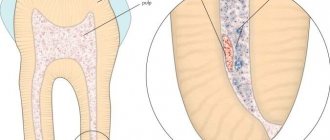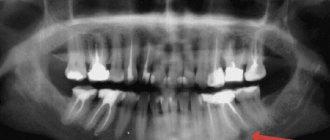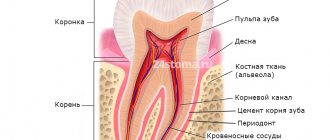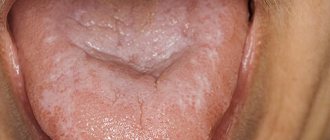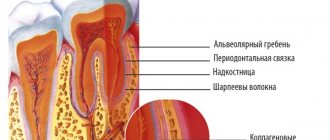If you suddenly have a severe toothache and the pain is throbbing, sharp, unbearable, then such symptoms may indicate tooth pulpitis. What kind of disease is pulpitis, why does it appear, how can it be cured and the tooth saved? We will answer all these questions in detail in this article. After reading the material, you will learn how tooth pulpitis occurs, what methods of its treatment are used in modern dentistry, and whether it is possible to cure tooth pulpitis at home or not.
Pulpitis of the tooth and its treatment
A characteristic sign of this pathology is inflammation in the pulp, which is located inside the tooth cavity, where blood vessels and nerves are concentrated. The cause of inflammation is the penetration of harmful bacteria into the cavity due to damage to the external dental tissues (enamel and dentin). This is the destruction that we most often owe to untimely treatment of deep dental caries: pulpitis becomes a consequence of the carious process. Much less often, it appears due to mechanical damage to the pulp, poor preparation of the tooth for filling, and unprofessional installation of orthopedic structures.
Treatment methods for pulpitis
In dentistry, two main methods are used to treat dental pulpitis in adults and children:
- biological - drug treatment of pulpitis with antibiotics and medications;
- surgical - treatment of pulpitis by amputation (partial removal of the pulp) or extirpation (in which the nerve of the tooth is completely removed).
The choice of technique remains with the dentist. The doctor studies X-ray diagnostic data, interviews and examines the patient. Based on these data, he selects the most rational method of treating pulpitis for a particular case.
Causes of pulpitis
Pulpitis develops due to infection. Untreated dental caries is the main cause of this disease. The carious cavity contains bacteria and microorganisms that gradually destroy the tooth. And when the destruction reaches the nerve, pain occurs.
Stages of pulpitis
The disease is characterized by different stages and its manifestations and intensity of pain.
Purulent pulpitis
This acute stage manifests itself as unbearable, constantly throbbing pain. It intensifies in the evening, sometimes patients wake up at night from a painful attack. Pain occurs not only in the area of the affected tooth, but also radiates to the jaw, ear, and temple. Cold water can help relieve pain, but it is important to remember that easing the symptoms of the disease is not a cure. It is necessary to eliminate the cause – inflammation. If this is not done, necrotic decay of the nerve will begin.
Acute pulpitis
Acute toothache that occurs when eating hot/cold food or when a stream of air hits the tooth is the main symptom of such pulpitis. The pain goes away after the irritant is removed. Sometimes the pain subsides for a long time.
But since the pain appears, it means that there is serious inflammation in the tooth, which arose due to caries. Microorganisms entered the nerve and pain appeared. At this point, the disease is characterized by severe pain with throbbing. It occurs in the evening and at night, maybe only a couple of minutes or even persists throughout the day.
Chronic pulpitis (gangrenous)
This form appears when pulpitis is already advanced, and no treatment has been carried out for a long time. Under the influence of external stimuli, pain appears, as soon as the stimuli are eliminated, it goes away.
The most dangerous thing about gangrenous pulpitis is that the pain can occur suddenly. It is characterized as a strong pulsation. Sometimes there is a “dull” soreness. Often, at the time of treatment of this form, there is some pain and bleeding from the tooth.
Sometimes the disease can occur without symptoms. For example, when there is no obvious carious cavity, therefore, irritants do not enter the tooth and do not cause pain.
Types of pulpitis
The dentist’s treatment tactics will depend on which tooth this disease occurs on.
Front tooth
The symptoms will be the same as on chewing teeth. It is not difficult to diagnose such pulpitis. In addition to the main clinical picture, the tooth pulp will be visible through the enamel. Pain of unclear localization often occurs: the patient points to a completely different tooth. In addition to the main treatment, painkillers are prescribed, and when filling the crown of the tooth, the aesthetics are carefully restored.
Pulpitis of wisdom tooth
On this tooth, pulpitis develops for the same reasons as on other teeth and the clinical manifestations are the same. Often it is not possible to treat “figure eights”, since they are located very far away, have a complex anatomy, or even grow “into the cheek”. Therefore, in such a situation, tooth extraction is prescribed.
What happens if pulpitis is not cured?
Any disease cannot go away on its own unless the cause is eliminated. Pulpitis of the tooth is no exception. The infection in the tooth will only spread, the nerve will die, and microorganisms will spread beyond the root of the tooth into the bone tissue - into the periodontium. If pulpitis is not cured, periodontitis will occur.
Complications can also include deterioration of the condition of the tooth, through the transition of one stage of the disease to another: a purulent form to a gangrenous form or to nerve necrosis. If you do not pay attention to the first symptoms and neglect the tooth, the treatment will be much more expensive, and sometimes even tooth extraction will be required.
Patients often turn to the doctor late, since pulpitis is asymptomatic. This is the danger of this disease: there is no concern, but the inflammatory process continues and affects more and more tissues. Or a slight pain occurs, then quickly passes, and the patient thinks that everything is fine with the tooth. It is important not to forget that if tooth pain ever occurs, there is a reason to consult a dentist.
Methods and methods for treating pulpitis (how is tooth pulpitis treated?)
Many patients have the opinion that treatment of pulpitis is very painful, but in fact, modern dentistry has done everything to make the treatment comfortable. In any case, the treatment method and the number of visits are determined only by the dentist after examination. Based on objective data, x-rays and medical history, a decision is made on the choice of treatment tactics.
Treatment of pulpitis in one visit
Such treatment is possible if the tooth has a minor carious cavity, there is no extensive damage, and the infection has spread slightly. Based on these data, and also if the patient agrees to carry out treatment immediately, the doctor begins his manipulations.
Treatment in two visits
If the pulpitis has a complex shape, or the tooth is severely damaged by caries, then two or more visits are prescribed. Then all non-viable tooth tissue is removed, the nerve is removed, the canal is washed and treated. The doctor will tell you more about these manipulations during the consultation and will allocate time for subsequent visits. Each visit, the doctor observes the tooth and, if necessary, can change the number of visits and the scheme of treatment procedures.
Surgical method for treating pulpitis
It involves removing the nerve from the tooth, and, if conditions exist, the doctor preserves the root pulp. If the nerve is completely removed, then the canals are cleaned and sealed. If the nerve is partially removed, a filling is placed on the tooth and its anatomical shape is restored.
Laser treatment of pulpitis
This method appeared in dentistry relatively recently. It is characterized by its painlessness. It is necessary to cauterize the nerve with a special laser without removing it. This technique allows you to save the nerve. First, a temporary filling is placed on the tooth, the doctor observes the tooth for a certain time, if there have been no relapses, the treatment is completed - a permanent filling.
Biological method of treating pulpitis (treatment of pulpitis without removing the nerve)
This method is conservative and involves preserving the pulp. It is recommended when the inflammation is not severe, or, for example, with a reversible form of pulpitis. Special medications are used.
How long does treatment take?
All cases are strictly individual and depend on the initial clinical picture. But there are two schemes: treatment in one visit and in two. In the latter case, the tooth is first covered with a temporary filling, and after a certain time the doctor completes the treatment.
What to do after treating pulpitis?
The doctor will tell you everything that needs to be done after treatment. Recommendations include avoiding too cold/hot food and eating after a while. In difficult clinical situations, a lack of physical activity and rest may be required.
Treatment of pulpitis during pregnancy
Pregnancy is a physiological state that requires increased attention to the health of mother and child. But when pain occurs, it is contraindicated to endure it or self-medicate. This can lead to serious complications affecting not only the oral cavity, but also the pregnant woman’s body as a whole.
Under no circumstances should treatment be delayed, as this can lead to serious consequences. During the consultation, the dentist will help you choose a safe treatment method that will not harm mother and baby. The method of pain relief is also carefully selected. In addition, X-ray examinations are not prescribed (except for complex clinical cases).
At the initial consultation, you must tell the doctor about the duration of your pregnancy and, if any, any health conditions (for example, the presence of allergic reactions or heart and vascular diseases). After the examination, the dentist will make a diagnosis and tell you when to start treatment.
The dentist will provide you with the most complete information about the condition of your teeth and the need for their treatment. Frequently asked questions during the consultation: is it painful to remove a nerve, is it possible to do without removing it, when does a tooth need to be removed, does the treatment take place in one visit, what is the cost of treatment, etc. Our specialists will tell you in detail about everything related to dental treatment.
Biological method of treating pulpitis
If the disease has become chronic, a biological method or conservative treatment of pulpitis with calcium is used. The process involves applying therapeutic pads containing calcium preparations. The technique is also used in the following cases:
- if the pulp was accidentally exposed during the caries treatment procedure;
- when you need to strengthen the bone partition between tooth enamel and pulp.
The specialist applies a drug for the treatment of pulpitis to the site of thinning bone tissue and thereby strengthens it. Next, the tooth is filled and monitored over time, conducting X-ray examinations at certain time intervals. The method is suitable:
- children with baby teeth;
- patients under 30 years of age during the treatment of reversible pulpitis;
- everyone who takes special care of their oral cavity.
If, after treatment of pulpitis, the tooth aches, hurts when pressed or bitten, and the pain remains for a long time, intensifies at night, and becomes long-lasting, you must return to the clinic. Aching pain during the treatment of pulpitis indicates that more radical, that is, surgical, methods are needed.
How is pulpitis treated surgically?
As we have already noted, there are two possible options for surgical intervention:
- treatment of pulpitis using the amputation method with partial preservation of the pulp;
- treatment with complete removal of soft tissues, blood vessels, and nerves.
If there is an objective possibility, the doctor will remove only the top of the pulp - from the crown, leaving the root part. The blood supply and sensitivity (innervation) of the tooth will be preserved. The technique is used in the treatment of children - for milk or permanent teeth that have not yet fully grown. This allows them to form normally in the future. Treatment for pulpitis can be carried out in one visit.
Pulp - what is it for?
The pulp is a fibrous connective tissue penetrated by nerve endings and blood vessels.
Its shape completely follows the tooth, and is located in the center of the root part, filling the entire cavity. On top, the pulp is protected by a hard enamel layer, which prevents injury from the outside.
Main functions of the dental nerve:
- responsible for the formation, proper growth of teeth and blood supply;
- protects channels from pathogenic microbes;
- supplies the tooth with useful micro- and macroelements.
In addition, the pulp is responsible for the sensitivity of the tooth, that is, for its reaction upon contact with hot, cold, sour, sweet, and so on.
Reference! The dental pulp in adults is thinner than in children. This is due to age-related changes and a slowdown in regeneration processes. The older a person is, the thinner and weaker the nerve becomes, and the tooth begins to experience a deficiency of nutrients.
Treatment of acute pulpitis
The above methods are ineffective in treating exacerbations of chronic pulpitis, an acute disease when the tooth becomes a source of unbearable pain radiating to the ear, temple, and back of the head. With these symptoms, endodontic treatment of pulpitis is carried out - with cleaning of the root canals and complete removal of the pulp.
In dentistry, two modern methods of treating tooth canals for pulpitis are used: devital and vital.
- Treatment of pulpitis using the vital amputation method is carried out by removing the nerve, washing, cleaning and filling the canal.
- Devital treatment of pulpitis involves the use of medicinal pastes and requires several sessions.
These treatment methods are most often used for pulpitis on permanent teeth.
Why are patients afraid to remove nerves in a tooth?
Previously, in the process of removing a nerve in a tooth, dentists used arsenic by applying it to the affected pulp. The patient was then given a temporary filling, which was removed two days later along with the arsenic, after which the nerve was removed. This procedure took quite a long time, causing discomfort. Currently, thanks to modern technologies, the process of removing a nerve in a tooth lasts about half an hour and is carried out under local anesthesia. If the X-ray results are good, the canals and the carious cavity, cleared of bacteria, are filled.
To avoid such radical actions as removing a nerve in a tooth, you must:
- Carry out hygiene procedures as efficiently as possible
- Don't forget the importance of professional teeth cleaning
- Regularly visit the dentist, who will notice any carious lesion during a visual examination much earlier than it reaches the pulp and requires removal of the nerve.
Stages and stages of tooth treatment for pulpitis using the devital method
- Stage I.
The tooth is anesthetized and the carious cavity is cleaned. The pulp cavity is opened. - Stage II.
A devitalizing paste is placed into the exposed pulp and the tooth is filled for 3 to 7 days. People still call the paste “arsenic,” although it has nothing to do with this substance. - Stage III.
During your next visit, your dentist will clean the root canals according to medical protocol. - Stage IV.
If there is a risk that the tooth will crack, it is covered with a crown. If the hard tissues are well preserved or only slightly damaged, they are restored. The tooth is strengthened with a fiberglass or metal anchor pin and securely filled with photopolymer material.
The treatment time for pulpitis depends on how damaged the tooth is, the age of the patient, whether there are complications, and how many root canals should be treated.
Is it painful to treat pulpitis?
Many patients believe that treatment for pulpitis is painful. In fact, pain accompanies the disease itself, and not the procedure for its treatment. The pulp tissue and nerves become inflamed, which causes unbearable painful sensations comparable to an electric shock. Pulp removal is absolutely comfortable, because high-quality anesthetics completely relieve the patient of pain while the doctor prepares the canals. During treatment or after treatment of pulpitis, the tooth hurts when the internal tissues are severely inflamed. Then safe painkillers are prescribed while healing occurs (1 - 3 days).
Removal process
Depulping or removing a nerve always begins with preparation. To do this, the doctor must conduct a thorough examination of the oral cavity, collect information about the person’s health, and take the necessary tests. Only after this can he begin the nerve removal procedure, which is a simple operation lasting about 1 hour.
The first stage involves the administration of an anesthetic instead of surgery. Its effect begins after about 10 minutes and lasts for 1-2 hours, depending on the dose. General anesthesia, usually in the form of a sleeping gas, may also be used. The action begins literally in 1-3 minutes.
After this, the doctor begins preparing the working area, isolating the tooth from saliva, opening it and other manipulations. Only after this does the nerve extraction procedure begin. It is carried out using a pulp extractor - a dental needle in the form of a spiral. Next, the pulp chamber is filled with an antiseptic, the canals are carefully sealed, a control photograph of the patient’s jaw is taken, and a permanent filling is fixed.
previous post
Is it possible to build up a front tooth?
next entry
Possible complications
If you delay visiting the dentist, inflammation can spread to the bone tissue of the tooth - periodontium. This is how one of the most common and dangerous complications of this disease begins - periodontitis, which can lead to tooth extraction. Periodontitis also occurs due to an unskilled approach to cleaning root canals.
If you are concerned about an elevated temperature after treatment for pulpitis, urgently contact a more reputable dentist, as the inflammation is progressing. Professional clinics use modern methods of canal treatment using microscopes, binoculars, visiographs, endomotors, and apex locators. These instruments prevent the risk of complications.
Unfortunately, pulpitis remains a common occurrence after caries treatment. The reason for its appearance is the same - the unprofessional actions of a doctor who violated medical protocols and made mistakes when filling. Perhaps he accidentally opened the pulp and gave bacteria access to it.
What is pulp and does it need to be removed?
The pulp, or dental nerve, is the connective tissue that fills the tooth cavity. It consists of fibers, nerve endings, lymphatic and blood vessels. The dental nerve supplies bone tissue with nutrients, is responsible for the proper development of the tooth and protects it from infection.
If the pulp is damaged, an inflammatory process begins, and the person experiences severe pain. After removal of the nerve, the tooth becomes “dead,” but with professional manipulation by a doctor, it fully retains its functions.
How much does tooth treatment for pulpitis cost?
The final cost of pulpitis treatment is influenced by many factors: the degree of destruction of hard tissue, the number of canals in the tooth, the presence of complications, concomitant diseases, and the chosen treatment method. If the tooth is permanent and has one canal, then the procedure in Moscow clinics will cost from 5,000 rubles. This amount includes a full range of services: x-ray diagnostics, application of anesthetic, installation of a rubber dam, treatment of caries, treatment of dental canals with cleaning, installation of a filling. Price may change if multiple sessions are required.
